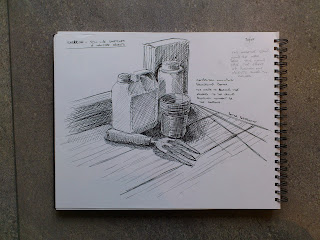Exercise - Still life sketches of made objects
It was a sunny day so I decided to go outside for this exercise. I found plenty of interesting objects in the polytunnel, so decided to set up my composition on the potting bench. Using a fineliner pen I sketched the same collection of items from slightly different viewpoints using crosshatching to define the forms. I also tried to establish why some compositions work better than others. My prefered composition can be seen in the top right corner of the sketchbook page below. I chose a slightly lower viewpoint which gave a more dramatic look to the objects, the top of the tallest items being level or above my eyeline. Almost like buildings! Another important element if found to the composition is how the edges of objects ovelap to break up the outlines and introduce an interesting interplay of shadows and reflections. |
| Prefered composition top right |
 |
| The addition of a small part of bench in this composition helps to anchor the objects in space |
Exercise - Composition of natural objects
For this exercise I chose to use some large seashells that have interesting surface patterns and textures. By using a spotlight I was able to create some strong shadows which by using appropriate tones in my drawings, helped to describe the forms and textures on the shells. I found it quite difficult when arranging the objects to create a composition that I was entirely happy with. For instance, how to create a composition that leads the eye around the drawing? I liked the way that an offset composition of objects had a more natural feel than centrally placed objects. Space to the right in the sketchbook page below, seemed to draw the eye back to the objects. Or is that just me? |
| Still life with an offset composition |
I also explored two other arrangements as seen in the page below. The rule of thirds considers placing important elements at the junctions of intersecting lines placed at 1/3 of the page. I also tried using the objects to create lines for the eye to follow.
Check and Log
I think its much easier to describe 3 dimensions when drawing man-made objects. I think this is because these objects are often regular in shape and have a symmetrical appearance. Our everyday experience with these objects means that we have an expectation of how they appear. If a drawing is not portraying an object as we expect, our senses immediately tell us something is wrong. When drawing, I find this helps me to decide if lines or tone have been applied correctly. The often irregular appearance of natural objects means that accurately describing them in a drawing requires much more careful observation.I created the feeling of solidity in objects by making sure that the shadows reflections and light describe accurately how the objects interact with their environment and other objects around them. For instance the shadow below an object tells you a lot about how it rests on a surface.
Changing the arrangement of the composition made me focus on why some arrangements appear to work better than others. Experimenting with different arrangements highlighted how the interaction of the objects, light and shadows allowed me to show the form of the objects.
In the same way that rearranging the objects created better compositions, how I positioned myself relative to the objects had an even greater effect as it was possible to dramatically effect the whole composition by simply moving my own position.



No comments:
Post a Comment